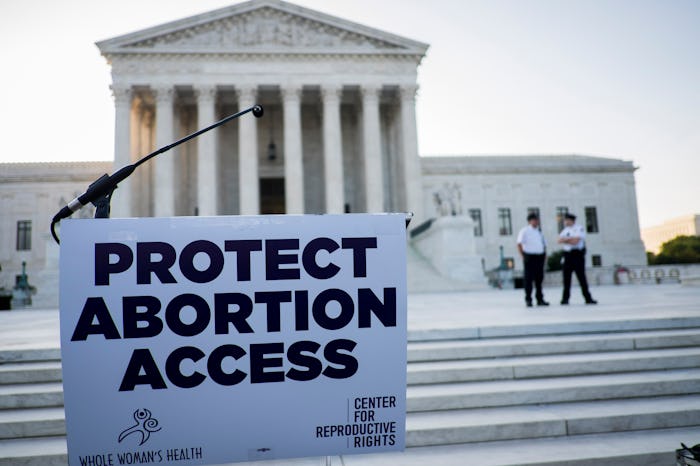Life

Report: Getting An Abortion In The U.S. Is Safe, But These Barriers Jeopardize Quality Of Care
Reproductive rights have always been a hot topic in American politics, with women’s bodies existing as a battle zone. Among these issues, abortion has always taken the forefront of debates, with some opponents using fear-mongering tactics to frighten women away. However, a recent report by the National Academy of Science, Engineering, and Medicine has found abortions in the United States to be perfectly safe, according to NPR, with blame for complications lying outside of the procedure itself.
In the report, titled “The Safety and Quality of Abortion Care in the United States,” the four major abortion methods (medication, aspiration, dilation and evacuation, and induction) were examined. In order to understand the scope of the entire procedure, the study also looked at women’s care before and after the procedure took place. According to the NPR, Ned Calogne, the co-chair of the committee that wrote the study, noted, “I would say the main takeaway is that abortions that are provided in the United States are safe and effective.”
The researchers found that about 90 percent of all abortions happen within the first 12 weeks of pregnancy. This isn’t an entirely new statistic, as Planned Parenthood noted that 92 percent of abortions are performed within the first 13 weeks. According to the same Planned Parenthood report, abortion has a low morbidity rate overall. When undergoing a legal abortion procedures at all gestational ages, complications that require serious hospitalization occur less than 0.3 percent of the time, according to Planned Parenthood.
The risk of death through abortion procedures is about one per million, up until 63 days of gestation, according to Planned Parenthood. But, according to the New England Journal of Medicine, the maternal mortality rate for live births in the United States has more than doubled since 1990, at 28 deaths per 100,000 live births in 2013. As it stands, as these statistics show, it can be riskier for women to carry a pregnancy to term than to elect to terminate with abortion procedures.
The earlier report found that blame for the majority of abortion related complications rested with anti-abortion legislation unnecessarily complicating the procedure. “There are some requirements that require clinicians to misinform women of the health risks, that you have to inform a woman that an abortion will increase her risk of breast cancer,” Calogne also told NPR.
According to the Guttmacher Institute, Calogne is correct in that five states require doctors to tell women there is a link between abortion and breast cancer. The most messed up thing about that policy is, as the Guttmacher Institute notes, there’s absolutely no evidence that breast cancer follows abortion. The Guttmacher Institute says that informed consent is the bedrock of medical ethics, with the obligation to provide accurate and unbiased information regulated by all 50 states. However, anti-abortion legislation has twisted this policy to provide information that is misleading or altogether false.
Guttmacher found that 27 states make women wait at least 24 hours for an abortion and 11 states require women to have an ultrasound before they can terminate their pregnancy. Some states place additional barriers by dictating who can perform abortions and where, such as requiring a doctor to have admitting privileges at a nearby hospital.
The National Academies report noted that “delays put the patient at greater risk of an adverse event”. These waiting periods and unnecessary restrictions make it so some women have to travel hours to receive appropriate care, while others have trouble booking appointments at all.
While there needs to be some form of legislation to ensure that women are continuing to receive the safe abortions this report has found, the history of misinformed consent needs to be seen as a form of government manipulation. It falls into line with the viewpoint that has led to the United States boasting higher maternal mortality rates than both Canada and Europe, according to the New England Journal of Medicine.
Under President Donald Trump’s administration, it’s becoming increasingly important to have these honest conversations about reproductive health. One of the administration’s first moves was to repeal a mandate that required employers to offer insurance that covered women’s contraceptives, according to Vox. For many women, birth control was unaffordable or out of reach before the mandate passed. Now, not only can providers can seek religious exemption, but backpacking off the myth that birth control creates dangerous, promiscuous women, they can seek moral exemption as well, as Vox reported.
Plans to cut Medicaid will also be incredibly detrimental to women’s health, according to Guttmacher. In its first three years of service, Guttmacher noted the Affordable Care Act (ACA) was credited with reducing the population of uninsured women of reproductive age by a staggering 41 percent. The ACA repeal-and-replace bills that Congress tried to pass called for phasing out Medicaid expansions and cutting federal funding. While the repeal failed, the administration has encouraged states to implement work requirement programs, making it harder for people to qualify for coverage. Vox’s Dylan Scott previously reported that hundreds of thousands of Americans would lose coverage.
This means that in a country already struggling with reproductive health, fewer people will be able to access cancer screenings, birth control, adequate post and prenatal care, and abortion services. In general, women of color and low-income women are already targeted by these restrictions, and new ones won't help. It's time that the country begins to repeal inaccurate information that only furthers this isolation and barriers, and the National Academies report is definitely a strong start.